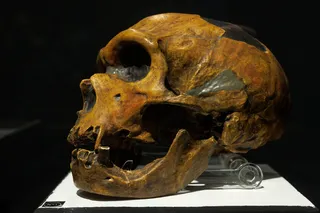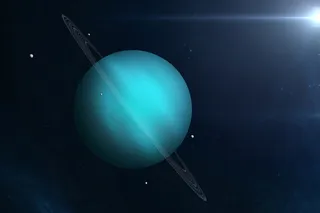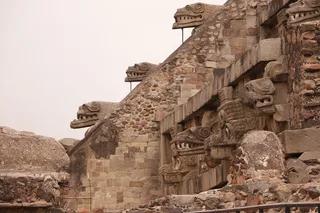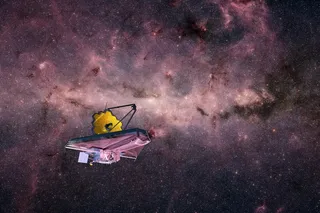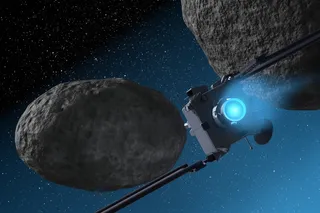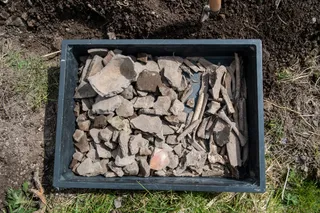You do not know what stuff is, you who hold it in your hands. Atoms? Yes, stuff is made of atoms. And every atom is a nucleus orbited by electrons. Every nucleus is built of protons. Every proton is - but there you reach the end of the line. Inside the proton lies the deep, unsettling truth: Stuff is made of nothing, or almost nothing, held together by glue, lots of glue. Physicists first began to suspect this in 1973. Lately it has been proved by experiment.

CERN Photo
Frank Wilczek was a 21-year-old graduate student at Princeton University when hehelped develop this theory of the proton in 1973. He didn't really understand it himself at first; he was just following where the math led him. "We did the calculations, but we didn't have a simple intuitive understanding," Wilczek says. "The physical picture came later." That picture took a while even for physicists to absorb, because it really isn't simple. Even today, if you ask a physicist to describe a proton, you'll first get a cartoon version—the one that says a proton is made simply of three smaller particles called quarks. That description is not exactly false—it's just low resolution. It's true the way a picture of Times Square from 30,000 feet away is true. The close-up reality, the one Wilczek and his colleagues got a glimpse of long ago, is far more madding and strange.
A proton is made of three quarks, yes, but the quarks are infinitesimal—just 2 percent or so of the proton's total mass. They're rattling around at near light speed inside the proton, but they're imprisoned in flickering clouds of other particles—other quarks, which materialize briefly and then vanish and, above all, gluons, which transmit the force that binds the quarks together. Gluons are massless and evanescent, but they carry most of the proton's energy. That is why it is more accurate to say protons are made of gluons rather than quarks. Protons are little blobs of glue—but even that picture conveys something too static and substantial. All is flux and crackling energy inside a proton; it is like an unending lightning storm in a bottle, a bottle less than .1 trillionth of an inch in diameter. "It's a very rich, dynamic structure," says Wilczek. "And it's very pleasing that we have a theory that can reproduce it."
Especially if you happen to be one of the guys who invented the theory, and if, more than two decades later, that theory is actually being verified by experiment. At a particle accelerator called HERA in Hamburg, Germany, physicists have been firing electrons into protons for the past eight years, showing just how insubstantial the quarks are inside. Meanwhile, other accelerator experiments may soon reveal how the universe assembled all its protons in the first place. In February, physicists at CERN, the European Laboratory for Particle Physics outside Geneva, announced "compelling evidence" that they had succeeded in melting large numbers of protons, creating for an instant the kind of quark-gluon plasma that last existed a microsecond after the Big Bang. All the protons around now congealed from that soup. At Brookhaven National Laboratory on Long Island in New York, a new and more powerful accelerator is getting set to cook quark-gluon soup on a daily basis this summer. By next year physicists may have a much better idea of what the universe was like when it was a billion times hotter than the surface of the sun, and quarks and gluons—not yet trapped inside protons, inside nuclei, inside atoms, inside us—could play freely in the quantum fields.
Quantum chromodynamics, or QCD, the theory that Wilczek and his colleagues invented, is a type of quantum field theory, and quantum field theory for beginners goes something like this. First, E=mc2, as Einstein discovered. That is, energy can be converted into mass and vice versa. Second, empty space is not empty: What we call a vacuum is actually seething with all kinds of energy fields, and the energy is constantly manifesting itself as "virtual" particles that pop into existence and then disappear again in something less than a trillionth of a nanosecond. "It wouldn't be very useful to us to see this structure of the vacuum," says Wilczek, who is now a professor at the Institute for Advanced Study at Princeton, where he lives in Einstein's old house. "It wouldn't help us avoid saber-toothed tigers or raise our children, so evolution has taught us to ignore it. But it's there."
Third (and last in our field-theory primer), when two subatomic particles exert a force on each other, they are interacting via one of those energy fields, which they themselves help to create. Specifically, they are exchanging one of those virtual particles—the quantum of the quantum field. An electron, for instance, has an electric charge of -1, and that charge generates an electric field. If the electron is moving, as it always is—spinning on its axis and orbiting the atomic nucleus—it generates a magnetic field as well; all magnetic fields are ultimately created by moving electric charges. When two charged particles interact—when, say, an electron is scattered off a proton in HERA—they exchange a virtual photon, the quantum of the electromagnetic field. The theory that describes such interactions, invented by Richard Feynman, among others, is called quantum electrodynamics, or QED.
In QED each individual electron is surrounded by a cloud of short-lived virtual particles—photons, but also other electrons paired with positrons, their positively charged antimatter twins. Those swarming particle pairs form a screen that partially cancels the electron field—at least as seen from outside the screen. From inside the screen, on the other hand, the field seems stronger than you might expect, like a bare lightbulb once a lamp shade has been removed. "OK, so that's screening, and that's pretty easy to understand," says Wilczek. "What happens in QCD, inside the proton, is just the opposite: It's antiscreening. It was a surprise even to us, so it can't be too simple. But we've come to understand it in more elementary terms over the years."
The early 1970s, when Wilczek did his pioneering work, was a heady time for particle physicists. Their air is somewhat different from what the rest of us breathe, and QCD was in it. A few years earlier, researchers at the Stanford Linear Accelerator Center had for the first time accelerated electrons to energies high enough to penetrate protons. The electrons didn't seem to be plunging into mush; they seemed to bounce off pointlike nuggets within the protons. Quarks, which had been postulated in 1964 as purely mathematical entities, began to seem as if they might really exist inside protons—and the question of how the whole thing was held together became urgent and exciting. While Wilczek and his adviser, David Gross, were discovering the answer at Princeton, another graduate student named David Politzer was discovering it independently at Harvard. Gross was the old man of the trio at 31. "We were lucky to have been young then," he wrote later, "when we could stroll along the newly opened beaches and pick up the many beautiful shells that experiment had revealed."
One shell was stranger than the rest. The Stanford experiments had seemed to show that the force between quarks—known as the strong force—actually got weaker as the quarks got closer together. That was very strange. The forces we encounter on a daily basis, electromagnetism and gravity, act in just the opposite way: They are stronger at short distances from their source and weaker at long ones. That is the intuitive way; that is how things should be. Otherwise, for instance, magnets would fly off your refrigerator to cling to the distant alluring stove—except that from a distance the fridge would start to look good to them again. And yet, weak as the strong force was at very short distances, it was strong enough at longer ones to frustrate physicists who had tried hard and failed to pull a quark out of a proton. No one had managed to observe one in isolation.
Wilczek and Gross went looking for a quantum field theory that could explain such a force. Actually Gross expected them to fail; he wanted to prove that field theory was a dead end. But one kind of mathematical formalism, called non-Abelian gauge theory, had not yet been tried. Wilczek spent half a year filling a notebook with calculations of how particles would interact through a non-Abelian quantum field. At the end he had a force that got stronger at close quarters, as a good force should, as Gross expected—but unlike what had been measured at Stanford. Wilczek checked the lengthy calculations over and over again. Then Gross spotted a single plus sign in the field equation that should have been a minus. That sign change changed everything: QCD was born.
Inside a proton, according to QCD, the quarks are "asymptotically free," as the Stanford results suggested, meaning they move almost as if there were no force between them at all. But the freedom is an illusion: A quark can never escape its partners. As the distance between them increases, so does the force, and so a wayward quark is inevitably reined in, like a bungee jumper. That's why no one ever has or ever will see a lone quark, which, when you think about it, is deeply weird. "The proton has parts, but it can't be taken apart," says Alvaro de Rújula, a theoretical physicist at CERN. "You can hold an electron in your hand. You can't hold a quark or a gluon in your hand."
The weirdness comes from the gluons. Quantum chromodynamics, the force that holds protons together, is modeled closely on quantum electrodynamics, the force that holds atoms together—but the gluons change screening to antiscreening, intuitive to bizarre. In quantum chromodynamics, quarks carry a new kind of charge, called color—which has nothing to do with ordinary color—and those charges generate a color field (hence the name chromodynamics). The quantum of the field, and the transmitter of the strong force, is the gluon. Like the photon that transmits the electromagnetic force, a gluon is massless. But unlike the photon, a gluon is charged. It generates its own color field, exerts its own strong force, and ineracts with other gluons. It leads a rich life.
The color field, like the electromagnetic one, can be thought of as having two components—call them color electric and color magnetic. A fast-moving color charge—gluons move at light speed—generates a strong color-magnetic field. Gluons are thus like little dipole magnets. The gluons that surround a quark align themselves parallel to its color field, as magnets would, and so instead of weakening it, as virtual particles do an electron's field, they strengthen it. They antiscreen the quark, amplifying its field. Here the lamp analogy no longer works—the quark is a dim bulb that somehow becomes brighter outside the shade.
That's what holds a proton together, and that's what gives it a bizarre internal structure. If one quark manages to get inside another's gluon cloud, it feels only a feeble attraction. But the farther away it goes, the more it feels the added pull of gluons—gluons emitted by the quarks, gluons emitted by other gluons, gluons that materialize into virtual quark-antiquark pairs, which exchange more gluons. "The quarks trigger the whole thing, but once it starts, it's a very powerful process, because the gluons interact," says Wilczek. "It's a sort of runaway process."
In 1974, De Rújula, Politzer, Wilczek, and a few other physicists proposed this gluonization of the proton and suggested how it might one day be measured. Two decades later, scientists at HERA started doing just that. HERA is a ring-shaped accelerator, nearly four miles around, in which electrons doing 47,000 laps a second are smashed into protons going the other way. The greater the energy of the collision, the deeper an electron can bore into a proton before being deflected. By measuring how the electron is deflected in millions of collisions, physicists can collect information on the internal components that are doing the deflecting. It's like taking a picture of the inside of a proton, Wilczek says, pixel by pixel—and the results fit the proposal he and his colleagues made decades ago.
"It's only at the crudest level that a proton is made of three quarks," Wilczek says. "When you look close and get inside these clouds and start seeing the basic structure, you see that it's mostly glue."
Which makes all the more interesting the question of how the universe ever managed to design such a thing.
To visit a particle-physics laboratory is to be struck by a contrast in scale—between the smallness of the objects being studied and the hugeness of the resources—people, machinery, computing power, electric power, space, money—that are being devoted to it. (If that infrastructure seems a high price to pay for information on the origin of the universe, consider that the Web—designed to help scientists communicate enormous data files—is a CERN brainchild.) CERN consumes almost as much electricity as the city of Geneva, its neighbor. CERN's biggest accelerator, the Large Electron-Positron collider, occupies a circular tunnel 17 miles around. In the coming years it will be dismantled and replaced by an even more powerful accelerator, the Large Hadron Collider, which will re-create the energy that existed a trillionth of a second after the Big Bang. (Hadrons are nuclear particles, like protons, that are made of quarks and gluons.) To make a quark-gluon plasma, you don't need to go that far back in time—the first microsecond will do—so you need a less powerful accelerator.
Still, the Super Proton Synchrotron at CERN is more than four miles around. It's housed in a tunnel that lies 300 feet underground, and in that tunnel, inside an aluminum tube just a few inches wide, lead nuclei are accelerated by magnets to 99.9 percent of the speed of light. They are then guided up to the surface and into an immense, factorylike hall, 300 yards long. The aluminum tube forks into different detectors, where the lead nuclei—each one consisting of 208 protons and neutrons, the electrically neutral twins of protons—smash into a piece of lead foil that is just a few hundred micrometers thick.
What happens next, in theory, is simple: The collision creates a fireball intense enough to melt the protons and neutrons. The quarks and gluons circulate freely, as they do deep inside a proton, but now over a region that is many protons wide, forming a quark-gluon plasma. "If you run the movie of the Big Bang backward, it gets denser and denser, hotter and hotter," says Reinhard Stock of the University of Frankfurt, who helped design one of the CERN detectors, "and we know that all bound structures break up when their energy density exceeds their binding energy." Quantum chromodynamics demands that a quark-gluon plasma exists at a certain energy density, "but you have to prove that it exists," says Stock. "And that's why we have been here for the last 15 years."
The problem is that the laboratory fireball expands rapidly and cools rapidly, just as the primordial one must have done. The plasma survives for only 10–22 of a second before the quarks and gluons condense again into protons and other hadrons. What physicists actually detect is a spray of thousands of such particles coming out the back of the lead foil. In Stock's detector, the particles then fly through a room-sized box of argon gas, knocking electrons off argon atoms. Counters record the electrons, and computers reconstruct the particle tracks, which reveal their identity. Once physicists have analyzed the data deluge—each collision yields 10 megabytes of data, and Stock and his colleagues have recorded millions of collisions—they may learn something about the plasma-producing fireball.
Over the past few years, Stock's detectors and others at CERN have confirmed that the fireballs are hot enough and dense enough to produce quark-gluon plasma. They have found an excess of particles containing "strange" quarks and a dearth of ones containing "charm"—both of which are side effects predicted by quantum chromodynamics. (Strange quarks and charm quarks are exotic kinds not found in ordinary particles.) It all amounts to a powerful case that CERN has been creating quark-gluon plasma—but it does not amount to proof. "The problem is they haven't been able to observe it directly," says Tom Ludlam, a physicist at Brookhaven National Laboratory.
Brookhaven's Relativistic Heavy Ion Collider, which is scheduled to begin doing physics this summer, will collide nuclei of gold at 10 times the energy possible at CERN and so achieve temperatures that will allow a quark-gluon plasma to survive a tiny moment longer. As the quarks cool down from a trillion degrees, they should emit heat radiation, in the form of gamma-ray photons. That is the most direct possible signal from the quark-gluon plasma, and Brookhaven's collider should be able to detect it. You can think of it as the flash of light the universe emitted when all its protons were born.
Even the scientists at Brookhaven won't be able to finally answer the question of where protons come from. A central mystery will remain. Inside a proton, as gluons come and go, as quarks and antiquarks come and go in their numberless swarms, one number remains constant: There are always three more quarks than there are antiquarks. Those are the quarks that, "at the very crudest level," as Wilczek puts it, make up the proton. Why are they matter and not antimatter? Why is the universe made of matter and not antimatter? The answer goes beyond quantum chromodynamics. A slight imbalance between quarks and antiquarks, if Wilczek and other theorists are right, was already present in the primordial quark-gluon plasma. Understanding its origin will require accelerators that reach even higher energies, such as CERN's Large Hadron Collider. It will require new kinds of theories—some of which, unfortunately, might demand that we start thinking of particles as tiny loops of string and the universe as having many more dimensions than the four we know and love.
As physics evolves, the image of the proton that quantum chromodynamics has given us may come to seem reassuringly concrete and solid—although solid is just what a proton is not. Flying into one—if you can imagine doing that, riding the strong force in a kind of subnuclear glider—would be like falling through Earth's atmosphere. The upper atmosphere of the proton is a thin cirrus of virtual quark-antiquark pairs; they form a shield for what lies below. As you fall past them, the atmosphere gets denser and denser, the clouds thicker and thicker. Your plane is struck with increasing frequency and force by flashes of color lightning—the gluons. And then, perhaps four fifths of the way through your descent, you emerge from the cloud cover. The ride is calmer now. The lightning bolts have not disappeared; they have fused to a continuous sheet, and somehow you feel at once featherlight and immune from all forces. You're near the center of the proton now, utterly trapped as you fall toward the asymptote of utter freedom, and you are finding . . . not much.
"The closer you look, the more you find the proton is dissolving into lots of particles, each of which is carrying very, very little energy," says Wilczek. "And the elements of reality that triggered the whole thing, the quarks, are these tiny little things in the middle of the cloud. In fact, if you follow the evolution to infinitely short distances, the triggering charge goes to zero. If you really study the equations, it gets almost mystical."




